Stock Markets Oversold Due for a Relief Rally
Stock-Markets / US Stock Markets Oct 05, 2008 - 01:33 PM GMTBy: Mike_Burk
 The good news is: We are probably near a tradable rally.
The good news is: We are probably near a tradable rally.
Short Term - Last Monday the financial system bailout was rejected for lack of pork, that oversight was corrected Friday. News of the bailout failure sent volume ratios on both the NYSE and NASDAQ to extremes not seen since October 19, 1987. Other breadth ratios hit extremes rarely seen.
The charts below each cover 3 months showing the NASDAQ composite (OTC) in blue and the ratio of NASDAQ advancing issues to declining issues in green. The ratio is calculated by dividing advancing issues by advancing issues + declining issues. Dashed vertical lines have been drawn on the 1st trading day of each month and dashed horizontal lines have been drawn at 10% intervals for the indicator. The charts show every extreme low for the indicator over the past 25 years.
The indicator had a value of 13.1 last Monday.
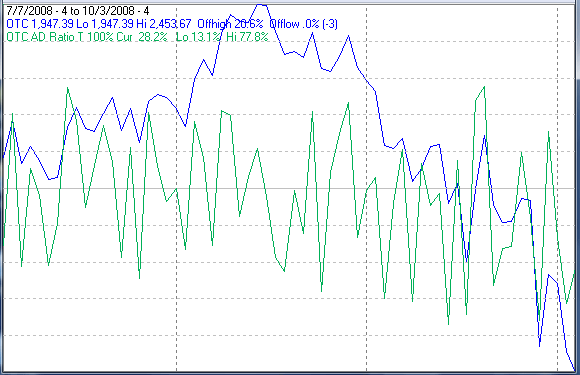
The next chart shows the same indicator and index in early 2007 when, in late February the indicator hit a value of 9.0. Conditions then were different from now because the index was only a few days off a high.

The next chart covers approximately the 2nd quarter of 2000. In mid April the indicator hit a value of 11.9. Following that extreme the index rallied for a couple weeks before falling to a new low about a month later.
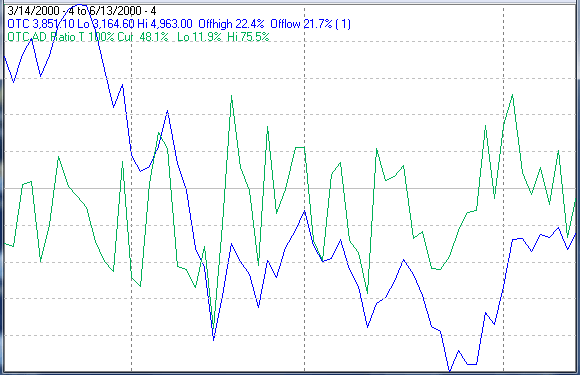
The next chart covers the period from August 4, 1998 to November 2, 1998. The indicator hit a low of 13.4 in late August. Following the August low the index rallied for about a month before falling to a new low.
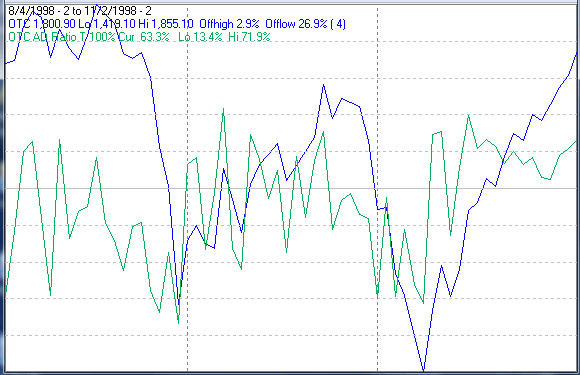
The next chart covers the 1990 decline. The indicator hit a low of 12.9 in late August, a short rally followed and the final index low was hit about 6 weeks later.
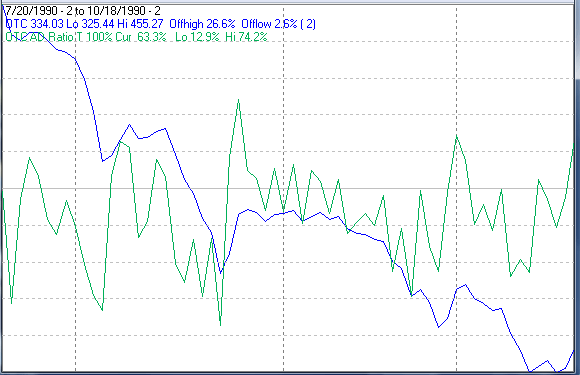
The most extreme example was the 1987 crash when the indicator fell to 3.7. The final index low was hit about 6 weeks later.

Every time the indicator has hit an extreme near its level of last Monday there has been a short rally and a lower index low, usually about 6 weeks later.
Intermediate Term
Last Monday there were 1170 new lows on the NYSE and 593 on the NASDAQ. On Friday as all of the major indices were hitting new lows the number of new lows had fallen to 678 on the NYSE and 398 on the NASDAQ. Any of those numbers is high enough to imply a high likelihood of a retest.
The chart below covers the past year showing the OTC in blue and a 10% trend (19 day EMA) of NASDAQ new lows (OTC NL) in black. OTC NL has been plotted on an inverted Y axis so decreasing new lows move the indicator upward (up is good).
The indicator has not confirmed the progressively lower index lows since January, but the value levels of the indicator have remained dangerously high.
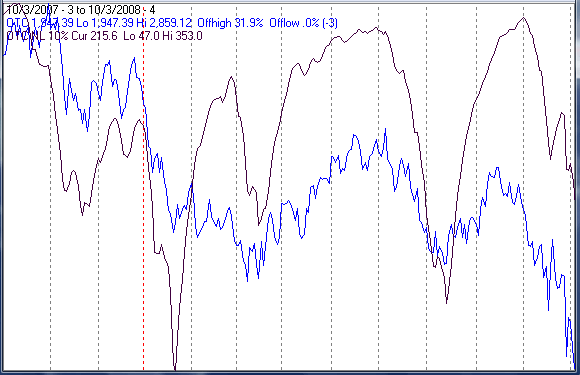
The next chart is similar to the one above except it shows the S&P 500 (SPX) in red and the indicator calculated from NYSE new lows (NY NL) in blue.
This chart is not as pretty as the one above in that the indicator confirmed the July and mid September lows.
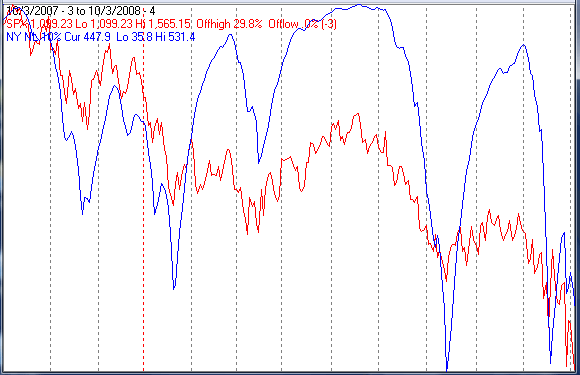
Seasonality
Next week includes the 5 trading days prior to the 2nd Friday of October during the 4th year of the Presidential Cycle.
The tables show the daily return on a percentage basis for the 5 trading days prior to the 2nd Friday of October during the 4th year of the Presidential Cycle. OTC data covers the period from 1963 - 2007 and SPX data from 1953 - 2007. Prior to 1953 the market traded 6 days a week so that data has been ignored. There are summaries for both the 4th year of the Presidential Cycle and all years combined.
Returns for the week have been modestly positive over all years, however, during the 4th year of the Presidential Cycle returns have been modestly negative.
Report for the week before the 2nd Friday of October.
The number following the year is the position in the presidential cycle.
Daily returns from Monday to 2nd Friday.
| OTC Presidential Year 4 | ||||||
| Year | Mon | Tue | Wed | Thur | Fri | Totals |
| 1964-4 | 0.07% | 0.19% | 0.30% | 0.35% | 1.04% | 1.94% |
| 1968-4 | -0.12% | -0.53% | 0.00% | 0.42% | -0.35% | -0.58% |
| 1972-4 | 0.30% | 0.40% | -0.35% | -0.54% | -0.53% | -0.73% |
| 1976-4 | 0.02% | -0.78% | -0.80% | 0.67% | -0.28% | -1.17% |
| 1980-4 | 1.33% | 0.08% | 0.51% | 0.18% | 0.13% | 2.24% |
| 1984-4 | -0.37% | -0.20% | -0.32% | 0.59% | 0.56% | 0.27% |
| Avg | 0.23% | -0.21% | -0.24% | 0.26% | -0.09% | 0.01% |
| 1988-4 | -0.05% | -0.05% | -0.71% | 0.24% | 0.29% | -0.28% |
| 1992-4 | -1.12% | 0.94% | -0.24% | 0.82% | -0.59% | -0.18% |
| 1996-4 | 0.26% | -0.86% | -0.18% | -0.08% | 0.91% | 0.06% |
| 2000-4 | -0.16% | -3.43% | -2.22% | -2.96% | 7.87% | -0.90% |
| 2004-4 | 0.53% | 0.16% | 0.79% | -1.14% | -1.47% | -1.13% |
| Avg | -0.11% | -0.65% | -0.51% | -0.62% | 1.41% | -0.48% |
| OTC summary for Presidential Year 4 1964 - 2004 | ||||||
| Avg | 0.06% | -0.37% | -0.32% | -0.13% | 0.69% | -0.04% |
| Win% | 55% | 45% | 30% | 64% | 55% | 36% |
| OTC summary for all years 1963 - 2007 | ||||||
| Avg | 0.00% | -0.27% | -0.09% | 0.32% | 0.53% | 0.50% |
| Win% | 62% | 47% | 50% | 71% | 69% | 58% |
| SPX Presidential Year 4 | ||||||
| Year | Mon | Tue | Wed | Thur | Fri | Totals |
| 1956-4 | -0.04% | -0.50% | 1.39% | -0.06% | 0.41% | 1.19% |
| 1960-4 | 0.20% | 0.15% | -0.13% | 0.78% | 0.53% | 1.53% |
| 1964-4 | 0.45% | 0.06% | 0.01% | 0.28% | 0.21% | 1.02% |
| 1968-4 | -0.01% | 0.04% | 0.00% | -0.43% | -0.11% | -0.51% |
| 1972-4 | 0.26% | 0.08% | -0.45% | -0.82% | -0.63% | -1.56% |
| 1976-4 | -0.13% | -0.77% | -0.25% | 0.55% | -0.95% | -1.55% |
| 1980-4 | 1.86% | -0.55% | 0.50% | -0.46% | -0.57% | 0.76% |
| 1984-4 | -0.34% | -0.28% | 0.27% | 0.41% | 0.86% | 0.92% |
| Avg | 0.33% | -0.30% | 0.02% | -0.15% | -0.28% | -0.39% |
| 1988-4 | 0.06% | -0.11% | -1.42% | 0.45% | 0.10% | -0.92% |
| 1992-4 | -0.71% | -0.10% | -0.72% | 0.87% | -1.25% | -1.90% |
| 1996-4 | 0.27% | -0.39% | -0.56% | -0.31% | 0.87% | -0.11% |
| 2000-4 | -0.49% | -1.07% | -1.62% | -2.55% | 3.34% | -2.39% |
| 2004-4 | 0.32% | -0.06% | 0.67% | -1.00% | -0.75% | -0.82% |
| Avg | -0.11% | -0.35% | -0.73% | -0.51% | 0.46% | -1.23% |
| SPX summary for Presidential Year 4 1956 - 2004 | ||||||
| Avg | 0.13% | -0.27% | -0.19% | -0.18% | 0.16% | -0.33% |
| Win% | 54% | 31% | 42% | 46% | 54% | 38% |
| SPX summary for all years 1953 - 2007 | ||||||
| Avg | 0.12% | -0.19% | 0.12% | 0.03% | 0.16% | 0.24% |
| Win% | 57% | 35% | 46% | 44% | 55% | 56% |
Money supply (M2)
The chart below was provided by Gordon Harms. The headlines tell us that central banks world wide have been dumping large amounts of money into the system yet it has not appeared in M2.
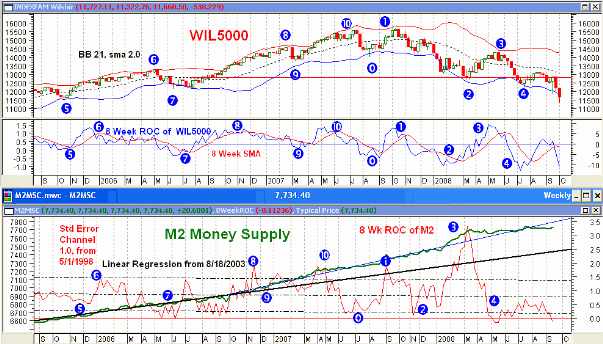
Conclusion
The market is oversold and due for a relief rally which should be followed by a retest of last Friday's lows or lower lows reached early next week.
I expect the major indices to be higher on Friday October 10 than they were on Friday October 3.
Last weeks positive forecast was a miss.
Thank you,
By Mike Burk
To subscribe to this report : http://alphaim.net/signup.html
Gordon Harms produces a Power Point for our local timing group. You can get a copy of that at: http://www.stockmarket-ta.com/ .
Disclaimer: Mike Burk is an employee and principal of Alpha Investment Management (Alpha) a registered investment advisor. Charts and figures presented herein are believed to be reliable but we cannot attest to their accuracy. Recent (last 10-15 yrs.) data has been supplied by CSI (csidata.com), FastTrack (fasttrack.net), Quotes Plus (qp2.com) and the Wall Street Journal (wsj.com). Historical data is from Barron's and ISI price books. The views expressed are provided for information purposes only and should not be construed in any way as investment advice. Furthermore, the opinions expressed may change without notice.
Mike Burk Archive |
© 2005-2022 http://www.MarketOracle.co.uk - The Market Oracle is a FREE Daily Financial Markets Analysis & Forecasting online publication.




